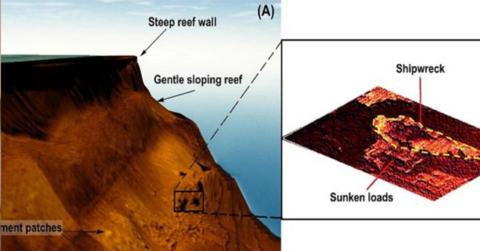Maritime Marvel: Nearly 2,000-Year-Old Ancient Roman Shipwreck Discovered in Egypt

Schematic seafloor 3D representation of the Roman shipwreck discovered in Egypt's Red Sea.
Researchers recently made a remarkable discovery of a substantial Ancient Roman shipwreck lying on the seafloor of the Red Sea along the Egyptian coast.
Utilizing advanced technology including a sonar-equipped Autonomous Underwater Vehicle (AUV) and other mapping tools, the oval-shaped wreck was located under 195 feet of water at the ancient Red Sea port of Myos Hormos.
This significant find, dormant and unseen for millennia, was unveiled in a paper titled "Exploration and identification of ancient Roman shipwreck located at Quseir, Red Sea," published in the Egyptian Journal of Aquatic Research recently.
Measuring approximately 100 feet in length and 25 feet in width, the ship is believed to have sunk during the first century A.D. while on a voyage from India.
This hypothesis is supported by the historical importance of the port during the Roman and Ptolemaic periods, serving as a crucial link between Arabia, India and the Mediterranean.
The cargo of the vessel, speculated to include wine, olive oil and a substantial amount of coins and metal, points to its role in ancient trade. Additionally, researchers found a collection of sunken cargo adjacent to the wreck, suggesting items that fell out during the sinking process.
Egypt's National Institute of Oceanography and Fisheries researchers, responsible for the discovery, propose that the ship was likely abandoned around the third century A.D. due to excessive silt.
Previous studies in the area have revealed evidence of settlements and trade activity from the first century B.C. until the early third century A.D.
Never miss a story — sign up for the Front Page Detectives newsletter. Be on the scene the moment news breaks.
The harbor area saw a revival in the 12th century with the establishment of the Arabic port of Quseir al-Qadim, after remaining deserted for a millennium. However, by then, it had significantly shrunk to a small bay.
The well-preserved condition of the wreck, owing to the Red Sea's peculiar lack of oxygen, impressed the researchers. Employing a multidisciplinary approach, they utilized innovative methodologies such as sonar, acoustic imaging technology and marine geophysical techniques to identify and characterize the shipwreck.
In their findings, the researchers emphasized the potential of their discovery to contribute significantly to education, research and cultural heritage preservation.
They propose that the wreck could become a focal point for Egypt's tourism industry, suggesting the establishment of sustainable tourism practices in collaboration with local authorities.
Become a Front Page Detective
Sign up to receive breaking
Front Page Detectives
news and exclusive investigations.
